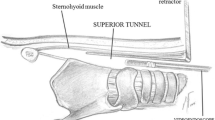Abstract
It is important to fully expose the posterior glottis to achieve adequate phonomicrosurgical resection of lesions in the posterior glottis. However, it is often difficult to obtain a sufficient view of the posterior glottis by ordinary direct laryngoscopy. We attempted to expose posterior glottic lesions using a triangular laryngoscope for adequate achievement of the surgery. We have performed phonomicrosurgery for 14 lesions in the posterior glottis including 5 early cancers, 1 dysplasia, 1 hemangioma, and 7 granulomatous lesions. Under general anesthesia, a triangular laryngoscope was set lateral to an intubation tube, shifting the tube anterolaterally toward the opposite side to expose the posterior glottis, which allowed simultaneous visualization of the vocal fold, the lateral wall, and a part of the posterior wall of the posterior glottis. The procedures were completed successfully in all cases. Modified placement of the triangular laryngoscope provided an excellent surgical view including the membranous portion of the vocal fold through the posterior glottis. All lesions have been well controlled during the follow up periods of 6–23 months. The triangular laryngoscope enables an alternative method for posterior glottic exposure. Modified placement of the laryngoscope can be easily performed and provides sufficient exposure of posterior glottic lesions for an adequate resection of those lesions.




Similar content being viewed by others
References
Hirano M, Kurita S, Kiyokawa K, Sato K (1986) Posterior glottis. Morphological study in excised human larynges. Ann Otol Rhinol Laryngol 95:576–581
Koufman JA (1991) The otolaryngologic manifestations of gastroesophageal reflux disease (GERD): a clinical investigation of 225 patients using ambulatory 24-hour pH monitoring and an experimental investigation of the role of acid and pepsin in the development of laryngeal injury. Laryngoscope 101(suppl 53):1–78
Jackson C (1915) Position of the patient for peroral endoscopy. Peroral endoscopy and laryngeal surgery. The Laryngoscope Co., St. Louis, pp 77–88
Zeitels SM, Vaughan CW (1994) “External counterpressure” and “internal distention” for optimal laryngoscopic exposure of the anterior glottal commissure. Ann Otol Rhinol Laryngol 103:669–675
Zeitels SM, Burns JA, Dailey SH (2004) Suspention laryngoscopy revisited. Ann Otol Rhinol Laryngol 113:16–22
Hochman II, Zeitels SM, Heaton JT (1999) Analysis of the forces and position required for direct laryngoscopic exposure of the anterior vocal folds. Ann Otol Rhinol Laryngol 108:715–724
Zeitels SM (1999) Universal modular glottiscope system: the evolution of a century of design and technique for direct laryngoscopy. Ann Otol Rhinol Laryngol Suppl 179:2–24
Kawaida M, Fukuda H, Kohno N (2001) Microlaryngosurgery for benign posterior glottal lesions using a posterior glottis direct laryngoscope. ORL J Otorhinolaryngol Relat Spec 63:127–130
Norton ML, Strong MS, Vaughan CW, Snow JC, Kripke BJ (1976) Endotracheal intubation and Venturi (jet) ventilation for laser microsurgery of the larynx. Ann Otol Rhinol Laryngol 85:656–663
Rubin JS, Patel A, Lennox P (2005) Subglottic jet ventilation for suspension microlaryngoscopy. J Voice 19(1):146–150
Braverman I, Sichel JY, Halimi P, Goldsher M, Kadari A (1994) Complication of jet ventilation during microlaryngeal surgery. Ann Otol Rhinol Laryngol 103:624–627
Hanson DG, Kamel PL, Kahrilas PJ (1995) Outcomes of antireflux therapy for the treatment of chronic laryngitis. Ann Otol Rhinol Laryngol 104:550–555
Wani MK, Woodson GE (1999) Laryngeal contact granuloma. Laryngoscope 109:1589–1593
Feder RJ, Michell MJ (1984) Hyperfunctional, hyperacidic, and intubation granulomas. Arch Otolaryngol 110:582–584
Ward PH, Hanson DG (1988) Reflux as an etiological factor of carcinoma of the laryngopharynx. Laryngoscope 98:1195–1199
Qadeer MA, Colabianchi N, Vaezi MF (2005) Is GERD a risk factor for laryngeal cancer? Laryngoscope 115(3):486–491
Author information
Authors and Affiliations
Corresponding author
Rights and permissions
About this article
Cite this article
Hirano, S., Yamashita, M., Ohno, T. et al. Phonomicrosurgery for posterior glottic lesions using triangular laryngoscope. Eur Arch Otorhinolaryngol 265, 435–440 (2008). https://doi.org/10.1007/s00405-007-0484-9
Received:
Accepted:
Published:
Issue Date:
DOI: https://doi.org/10.1007/s00405-007-0484-9




